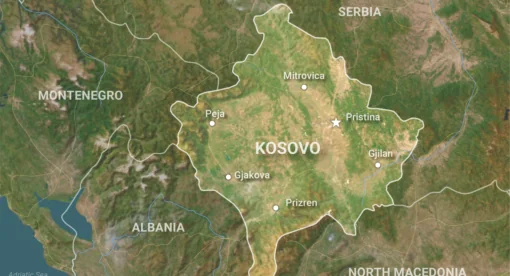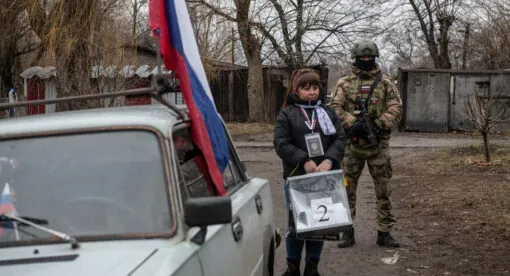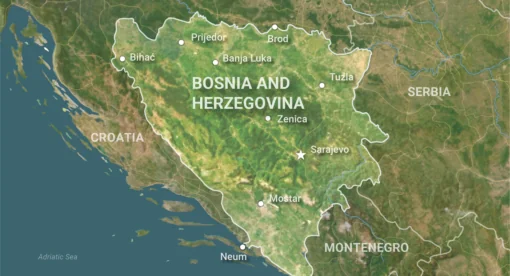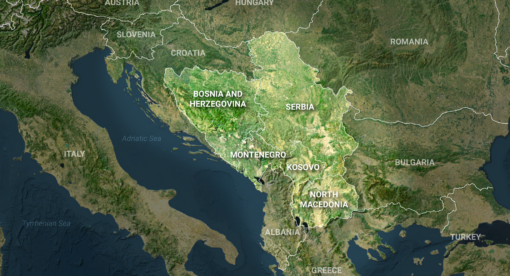Editor’s Note: This Terrain Analysis is part 10 of “ISIS 2020” – a series of briefings about the current status of the Islamic State by authors from different parts of the region. It is published by the Newlines Institute’s Nonstate Actors program. Parts one, two, three, four, five, six, seven, eight, and nine were released on April 28, May 5, May 12, May 19, May 26, June 2, June 4, and June 9 respectively.
In 2014, the Islamic State (ISIS) seized Mosul and later announced the establishment of a caliphate. While counterterrorism efforts initially focused on the group’s centers in Mosul and Raqqa, it is the areas adjacent to the Iraq-Syria borders that would prove to be the group’s last stand after major defeats. Eastern Syria had served as a point of strategic depth when ISIS arose in the aftermath of the fall of the Saddam regime. The area served as springboard for the group’s resurgence in the late 2000s and early 2010s, and in 2013-14 it allowed for the group to render Iraq and Syria into a singular battlespace.
Today, this cross-border frontier offers ISIS the ecosystem it needs to survive and restore its capabilities. Any strategy to achieve the enduring defeat of ISIS must focus on sanctuary denial on both sides of the Syria-Iraq border and address factors including social cohesion, economic opportunity, security, and trust in government. While there is currently no regime likely to do this in Syria, there are tangible steps Iraqi authorities can take to undermine the group’s support base and enablers in the area.
Favorable Conditions
An iconic image that accompanied the announcement of a caliphate was the destruction of military and police bases as well as sand berms that constituted the Iraqi-Syrian borders in an ISIS promotional video material titled “Removing Barriers.” The operation, meant to symbolize the advancement of the idea of a borderless caliphate, prompted jihadists from all around the world to flock to Iraq and Syria to join it.

The June 2014 video featured Abu Muhammad al-Adnani, who was the group’s official spokesman before he was killed in August 2016 in Aleppo. In the footage, al-Adnani declared, “After removing the barriers between Syria and Iraq, certainly the next step is announcing the reinstatement of the Islamic caliphate.” The declaration was confirmed in the chant, “Hands Extended to Pledge Allegiance to the Imam,” referring to then-ISIS leader Abu Bakr al-Baghdadi, who was proclaimed caliph, which was published by Ajnad Media Organization. ISIS reiterated the idea in an English-language production titled “The End of Sykes-Picot.”
Infighting among extremists, divisions along ethnic and tribal lines, social schisms, and the wide acceptance of the idea of removing borders among religious groups contributed to ISIS’s ability to gain control of the Syrian-Iraqi border region. On the Iraqi side, it controlled the 610-kilometer (379-mile) border from Anbar to Ninewa from 2014 to 2017. On the Syrian side, it controlled areas from south of Qamishli to Tanaf from 2012 to 2019.
In July 2014, ISIS established Wilayat al Furat (the Euphrates Province), which combined the border cities of Albu Kamal and Hajin in Syria and Qaim in Iraq. Then in March 2015, the group established Wilayat al Jazirah (Jazira Province), consisting of Sinjar, Zumar, Tal Afar, Tal Ubta, Hamdaniyah, Qayrawan, Shamal, Ayadhiyah, and Baaj. ISIS created these administrative regions as part of its strategy to maintain operations under one local leadership over contiguous territories. Those regions also tended to be old strongholds for jihadist groups and smugglers.
The border region has been crucial for ISIS’s financial and military operations. It is a corridor for all military and commercial transportation, and some areas have wealthy agriculture with plenty of grains, wheat, and cannabis. There are also vast deserts with trenches that can be used as hideaways for military operations and logistical needs as well as creating training camps. Additionally, tribes in the Iraqi towns and villages have strong familial and economic ties to tribes on the eastern side of Syria.

There are an estimated 1,000 villages in the west and southwest of Ninewa, west of Salah al-Din, northwest and west of Anbar, including more than 400 where Sunni populations have been prevented from returning for reasons including ethnic, sectarian, and security tensions. Fifty villages on the Iraqi side are located 10 to 25 kilometers (6.2 to 15.5 miles) into the Iraqi territories. On the Syrian side, there are roughly 51 villages located between 2 and 10 kilometers (between 1.2 and 6.2 miles) inside the Syrian territories. The official border crossings between the two countries are the Rabia Crossing in Ninewa and the Al Qaim and Al Walid Crossings in Anbar.
This border region was key for ISIS leaders; al-Baghdadi reportedly frequented the border regions to meet with his deputies in those cities, and al-Adnani made his announcement for “Removing Barriers” from this region. Several other ISIS leaders have been captured or killed in the region.
Due to the weak border enforcement on both sides and the fragility of border barriers on both sides, the existence of tunnels, and the presence of traditional and professional smuggling networks, most border regions are out of state control. Villagers, tribes, and gangs are involved in illicit activities across the region, from north Umm Al Jurayis to south Fishkhabur in western Ninewa.
ISIS grew in that region and continues to benefit from the conditions there. Iraqi intelligence officials continue to warn of ISIS’s and local smuggling networks’ use of conduits and roads in Iraq and Syria. In 2020, ISIS organized its local structures into two areas of operations in the Iraqi and Syrian states that included Jazirah and Anbar — extending from Sinjar to the triangle where the Iraqi, Syrian and Jordanian borders intersect — on the Iraqi side, and the Euphrates and Khayr from northern Hasakah to Tanaf and the Syrian Desert southwest of the Euphrates on the Syrian side. The reorganization was further proof of the importance of that region to the group.
Human Capital Along the Borders
According to the archives of the Sunni Endowment Office in Iraq, over 2,000 mosques and prayer centers exist in the border region, serving an area of 41,000 to 43,000 square kilometers (15,830 to 16,602 square miles), nearly 10 percent of Iraq’s territories. More than 85 percent of those who administer and frequent those mosques are followers of the Salafi trend; 5 percent are followers of the traditional Sufi sects; 8 percent follow the Muslim Brotherhood; and the rest are administered by mainstream Sunnis.
The population of the areas adjacent to the borders in Iraq is roughly 800,000. Of those, 500,000 are Yazidis and Kurds and 300,000 are Sunni Arabs.
ISIS clerics and supporters took advantage of the spread of Salafi beliefs to promote takfiri ideas and push for reviving the caliphate. They also encouraged anti-Shia sentiment and mobilized people to promote it, using a group of 350-400 imams and clerics. Those clerics succeeded in recruiting 8,700-9,000 members who worked on different issues at ISIS centers in those regions, according to documents that were found by coalition forces in As Saqara Village in Al Baaj district after liberating the area in August 2017.
The author’s research in those regions shows that most armed jihadist groups, including ISIS, focused on recruiting members from every tribe and turning them into evangelists and leaders at the top and middle levels. ISIS then used them as a pressure card against inhabitants of those cities, towns, and villages. The strongest members of ISIS were the ones with prestige and influence in those regions, gradually eliminating the role of moderate clerics.
Those regions can be considered the strategic stock of ISIS human capital. At the peak of ISIS expansion in Iraq and Syria in 2014, ISIS armies had approximately 32,000 combat, logistical, and civilian members. Those border regions provided 25 percent of ISIS human capital, including devotees, supporters, laborers, and servants.

Thriving Without Widespread Support
Although ISIS found substantial support for its ideology, many locals resisted its extreme interpretations of Islam and incurred great losses. According to official records, in Ninewa and Anbar between June 2014 and November 2017 ISIS militants killed 3,400 people, wounded 10,000, and displaced 250,000.
Three segments of the population in those border regions offered opportunities to ISIS:
- The first segment embraced common jihadist beliefs that can be considered ISIS’s permanent core. Members of this group embraced ISIS’s ideology, its imposition of the caliphate and its harsh rules on everyone, especially Sunni Arabs, and were prepared to die for the caliphate.
- A second segment did not embrace ISIS’s ideology but shared with it important political grievances and goals focused on undermining and retaliating against the political system and fighting local and national security forces. This group cannot be considered a permanent ISIS core because people here did not believe in the caliphate. Their support increased with feelings of marginalization and discrimination at the hands of the Shia-dominated Iraqi state.
- A third group can be described as opportunists who joined ISIS for pragmatic reasons, including financial ones. This group cannot be seen as a support base in any meaningful sense, because as and when the Iraqi state provides for economic opportunities, many within this category would end their support for ISIS.
ISIS did not choose the Iraqi-Syrian border region because of popular support; it did because it could take advantage of widespread political and economic disenfranchisement among Sunni Arabs alienated by both Damascus and Baghdad, the lack of state and security presence, and specific social structures conducive to manipulation and cooptation. That, combined with the region’s desert terrain, smuggling networks, tunnel systems, and rich agricultural resources, gave ISIS both a steady stream of recruits and financial self-sufficiency.
Vacuum in the Iraq-Syria Border Region
The conflict between law enforcement and smuggling groups on the borders, coupled with the fight between Turkey and the opposition Kurdistan Workers’ Party, which controls north and central Sinjar and is often targeted by Turkish forces and their Syrian allies, further increased the vulnerability of the border region.
As a result of the presence of ISIS camps, the simmering tension on the Iraqi side of the border, and the instability on the Syrian side, the region faces major threats. Since April 2019, ISIS units in Badiyah (Syrian Desert near Homs), Jazirah (Iraqi desert near Mosul), and western Ninewa have been preparing for the risk of terrorist operations in the border region turning into battles over border cities and towns. However, Iraqi security reports confirm that networks of ISIS remnants are still able to smuggle goods, individuals, oil, weapons, and narcotics through the border with Syria, making over $100,000 a day in revenue. Undoubtedly, as the feelings of economic depression and social marginalization grow among inhabitants of border villages as well as resentment over being occupied by Shia-majority forces, their desire to safeguard the borders will decline, and they may consider working with ISIS.
According to confessions made by captured ISIS members, the money helps facilitate infiltration across the Iraq-Syria border. In the first nine months of 2019, about 1,200 ISIS members moved over the border in small groups with the help of long-existing local smuggling networks and corrupt security officers and tribal leaders, especially after East Euphrates battles that ended in April 2019. This helped expand ISIS’s recruitment networks inside al-Hol Camp. Iraqi intelligence, through sources inside the camp, recorded 60 to 70 cases a month of individuals pledging allegiance to ISIS, adding up to more than 959 men and 570 women of different nationalities.
Iraqi intelligence officers, with the help of international coalition forces, also identified camps used to train fighters who crossed into Iraq, as well as weapons caches and tunnels used by ISIS cells.
ISIS revived its ties with local residents by engaging in illegal economic activities, with new emerging actors involved in smuggling goods and illicit trade in cigarettes, medicines, weapons, oil, narcotics, relics, scrap metal, copper, cement, food, and electronics. This effort was aided by Iraqi border enforcement and intelligence losing its contacts inside some of the smuggling networks in border towns because of animosity generated during the liberation operations and because they prevented the return of the displaced.
ISIS attacks originate from abandoned villages and areas between the Peshmerga-controlled districts and the Iraqi Security Forces-controlled districts, which include open swaths of land that are not inspected or monitored closely. In these areas, continuous decline in the logistical capabilities of the joint forces reduces the ability to control the border region and impose the rule of law. When the security forces are unable to provide security, any force with weapons could fill the void. Unlike law enforcement, armed groups have become effective and influential, especially pertaining to cross-border smuggling.
The revenue ISIS generates from the border economy provides the group with funds to carry out its terrorist attacks and obtain arms, food, medicine, vehicles, and anything else needed to survive and continue its activities, as well as for recruitment for support functions. A more recent revenue-generation strategy is to financially drain people in rural areas at the outskirts of liberated Iraqi provinces by burning down agricultural crops and imposing taxes on farmers and shepherds.

Recommendations
One of the best measures to stop attacks by ISIS remnants is to achieve social justice, find a solution for the displaced issue, close displacement camps, and ensure equal treatment toward regional and tribal mobilization forces. Those groups are key to breaking this vicious cycle, given that local residents are the most formidable force against ISIS if the Iraqi government invests in them and stops marginalizing them.
Local residents can create support for rejecting ISIS, but if local residents are marginalized, the group can feed off their insecurity, exploiting instability and disorder resulting from attacks and battles.
By this logic, Iraqi authorities can take a number of tangible steps to undermine ISIS and its sources of support. The Ministries of Interior and Defense, Peshmerga forces, and the Popular and Tribal Mobilization Forces are responsible for the policies controlling the fragile borders with Syria. Therefore, they must create a set of policies to lessen the impact of fragile borders, including:
- Enhancing coordination among border posts and creating a special command responsible solely for the border with Syria
- Providing advanced surveillance systems for border enforcement
- Utilizing unconventional technology for monitoring the border, such as drones
- Improving trust between security forces and residents of border towns and villages
- Combating corruption among border enforcement and incentivizing employees to reject bribes by giving them a percentage of the revenues reaped from foiled smuggling operations
- Refraining from draining the capabilities of the counterterrorism and rapid response forces at operations not related to combating terrorisim, as advised by the international coalition
Dr. Husham al-Hashimi was a Nonresident Fellow with the Newlines Institute. Dr. al-Hashimi was a leading security expert focusing on Islamist movements who advised the U.S.-led coalition to defeat the Islamic State. Al-Hashimi was also a member of the Iraq Advisory Council, a group of experts based in Iraq. He Tweeted at @hushamalhashimi.
The views expressed in this article are those of the author and not an official policy or position of the Newlines Institute.







